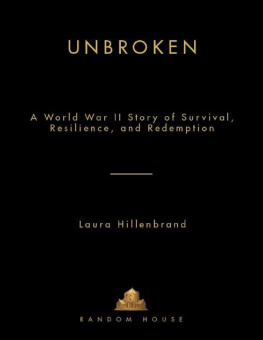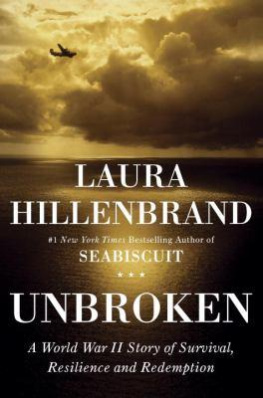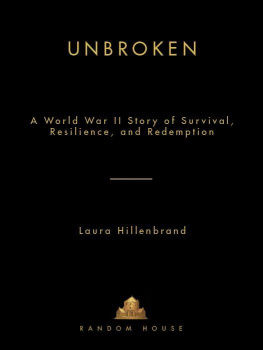Summary and Analysis of
Unbroken
A World War II Story of Survival, Resilience, and Redemption
Based on the Book by Laura Hillenbrand

Contents
Context
The Great Crusade of World War II drew the map of the world we know today, and many of the political freedoms we still enjoy are the result of the fight against fascism. The United States still sends soldiers to war in order to protect the freedoms people around the world have today, many of whom face daily brutality and cruelty, and sometimes, must overcome great odds to survive.
Although there are few veterans of World War II still alive today, author Laura Hillenbrand met a solider with a remarkable story of perseverance. Unbroken is the true story of Louis Zamperini, the man and solider who faced mind-numbing challengesfrom prejudice and bullying to very real and cruel enemies in war to haunted memorieswith determination and was able to find redemption and personal victory.
Since Unbroken s publication in 2010, the book has been a runaway success. It was on the New York Times bestseller list for more than four years and spent fourteen weeks at number one. The book was praised by readers and critics alike. In 2010, it was named Time magazines Top 10 Nonfiction Books and Publishers Weekly s Top 10 Best Books. In 2011, it received an Indies Choice Book Award, among other accolades. It was adapted into a young adult edition aimed at younger readers, and in 2014, it was turned into a major motion picture. Produced and directed by Angelina Jolie with a screenplay written by the Coen brothers, Richard LaGravenese, and William Nicholson, the film was included in American Film Institutes Top 10 Films of the Year.
Overview
Hillenbrand examines the life of Louis Zamperini, an unpromising juvenile delinquent whose brother helps him turn his life around to become a record-smashing Olympic runner. Shortly after the United States entered into World War II, Louie enlisted in the army. He became a skilled Air Corps bombardier who, after crashing in the Pacific, survived forty-seven days on a life raft only to be captured by Japanese soldiers and subjected to inhumane treatment for the next two years at a series of POW camps. Post-war, he was tormented by personal demons and wracked with post-traumatic stress disorder, until he met Billy Graham. Becoming a Christian and doing speaking tours in Japan helped Zamperini forgive his tormentors.
Laura Hillenbrand reconstructs elements of Zamperinis life in great and evocative detail. Through letters and interviews, the author brings to life not only the men who were with Zamperini on his life raft and in the Japanese camps, but the families they left behind. The suffering of the men is excruciating: starvation, thirst, and shark attacks, followed by the brutalities inflicted by the Japaneseparticularly the sadistic Mutsuhiro Watanabe, known as the Bird, who seemed dedicated to making Zamperinis life unbearable.
Hillenbrand follows some of Watanabes life after the Japanese surrender, providing a foil to Zamperini. Zamperini wrote to his former tormentor to forgive him, and even attempted to meet him in person, but it never came about. Though Louie was redeemed, the Bird was not. Louie founded a boys camp, became a motivational speaker, had a loving wife and family, got to carry the Olympic torch in triumph, and remained cheerful and active throughout his long and fruitful life. Louies is indeed a story of resilience and survival, the making of an average man into a triumph.
Summary
PART I
One: The One-Boy Insurgency
Louis Silvie Zamperini was born on January 26, 1917 in Olean, New York, to Italian immigrants Anthony and Louise Zamperini. In 1919, the family moved to California, where Anthony worked as a railway electrician. Louie was a fractious kid, picking up cigarette butts to smoke by age five, scaling the steeple of the Baptist church in the middle of the night and rousing the fire and police departments with incessant ringing, and playing all kinds of viciousand sometimes hilariouspranks. Nothing discouraged him and nothing put him on a more constructive path.
Meanwhile, his older brother, Pete, appeared to be his opposite. He was handsome and well groomed, he acted as protector to their sisters Sylvia and Virginia, and the whole town fawned over him. But Pete was also secretly a pranksterit was just that Louie was the one who always got caught. Louie wasnt very athletic; hed had pneumonia when he was little and remained skinny and slightly frail.
In the 1920s in Torrance, California, Italians were looked down on. Kids made fun of Louies poor English, and he was held back a grade. Bullies came after him, but he never backed down. In his teens, Louie began training with a punching bag his father made, and when a bully accosted him, he began to fight backhard. He got tougher, but also wilder. He punched a girl and pushed a teacher. His father tried to discipline him physically, and his mother tried bribing his friends to find out what he was up to, but nothing worked. Once, Louie ran away to San Diego and beat another kid bloody. He also stole. As he entered high school, Louie was shaping up to be a juvenile delinquent. He had no money and no plans for the future. His personal attempts at reformgiving away whatever he stole and helping out around the housealso failed. So Louie buried himself in Western novels and wished himself far away.
Two: Run Like Mad
In 1931, after Louie used a stolen key to swipe and then sell Torrance High School basketball tickets, the principal banned him from social and athletic activities. Louie didnt care, but his brother Pete, a star athlete, was able to convince the principal to allow Louie to join a sports teaman opportunity to give the struggling student positive reinforcement instead of the endless negative attention. Pete was a great runner and saw potential in his brother, so the two boys began to train in earnest, with Pete riding behind Louie on a bike and goading him to run faster. Although terrible at first, Louie quickly improved and began to win races. By seasons end, he was the first Torrance High athlete to make the All City Finals.
Louie liked winning, but not the strict regimen of traininghe even ran away from home with a friend to avoid it, only to return when his escape led to disaster. For the rest of the summer of 1932, Louie ran like mad. Under Petes coaching, he ran his paper route, he ran to the beach, and he ran back and forth to school. He even stopped drinking and smoking. Pete started Compton Junior College in the fall, where he was a star runner, but he came home most days to coach his brother. Although Louie learned strategy from Pete, he was a natural runner. His rolling hips gave him a long and efficient stride. Pete believed that he would excel at longer races, like the mile.
By 1933, in tenth grade, Louie began to shed his wilder ways. Popular students invited him to socialize, girls noticed him, and he was elected class president. When track season began, the training paid off. He won the 880-yard race, beating Petes record by two seconds. His mile time was 4:58, then set a state record at 4:50.6, then again at 4:46. The papers began reporting his achievements. When he beat all high school competition, he ran against college runners (including Pete), and he beat them all by fifty yards. He won the 1933 UCLA Cross Country mile race with no competition in sight. Louie had hit his stride.
Three: The Torrance Tornado













